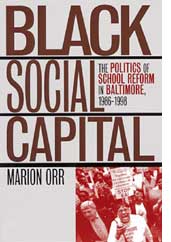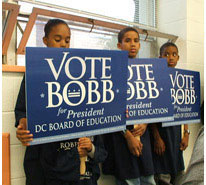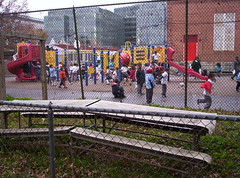Tonight: DC State of the Schools speech + my take
Tonight, Superintendent of Schools Clifford Janey will be speaking about the State of the Schools:
5:30 pm
McKinley Tech. High School, 151 T Street, NE.
Also see this piece from today's Examiner, "Janey to discuss improvements, future of schools," as well as this piece from the Sunday Post, "Why the Mayor Shouldn't Take Over D.C.'s Schools," by Michael Casserly, executive director of the Council of the Great City Schools.
1. My short take is that Mayor Elect Fenty would be making a mistake to push forward and seize control of the schools at the outset. There is no question that Mayor Fenty's initiative on this issue reflects the concerns that were made clear to him by voters during the campaign.
But like Pres. Clinton and the "gays in the military" debacle, my sense is that one should expend the kind of massive social, political and organizational capital required to take the schools over only if you truly have the answers and know that you will succeed.
What's the point of using up the majority of your political capital only to fail?
2. Because the fact of the matter is that DC's school system is about 1/20 the size of the NYC School system, and about 1/7 the size of the Chicago Public School system. The issues are much different here, and the problems in Chicago and NYC were to some extent about size and structure, but like here also about a failure to demand excellence and nepotism.
The DC system can be "fixed" if the public will is marshalled and accountability demanded and received and steps taken when not...
3. What I would recommend is that the Mayor and his Deputy Mayor for education act like Theodore Roosevelt (use the "bully pulpit," but still "walk [around] softly carrying [and using from time to time] a big stick"), Fiorello LaGuardia (charismatic populist who used the radio to great effect to reach and connect to New York City's citizens), and FDR ("fireside chats," "we have nothing to fear but fear itself") to hold the feet of the Superintendent, everyone who works for the school system, and the School board to the fire, to make change happen.
4. If that doesn't work, then seize the system. (But I do think Janey deserves a chance. Unlike a lot of "agency" heads, he's been doing quite a bit, in a very short time, in the midst of a very dysfunctional organization.)
5. This relates to something that I wrote some time ago, about the necessity of having a truly community-wide conversation about the schools, and creating a community committed to learning, and building that environment.
 Jefferson Junior High School, SW DC.
Jefferson Junior High School, SW DC.Engage the community, don't ignore us. Use this as an opportunity to build real civic engagement. I don't feel as if the citizens are really a part of this "conversation." (a/k/a "mushroom treatment," or "being seen and not heard")
(Also see Roy Strickland's paper, "City of Learning: School Design and Planning as Urban Revitalization in New Jersey, Berkeley, and Washington, D.C.." Strickland, a professor of urban design at the University of Michigan, led the planning exercise that created the "Schools on the Hill" revitalization proposal for the Spingarn Campus in Ward 5. This proposal has languished given the change in School administration.)
6. I am still "discouraged" that the principal of Walker-Evans Elementary School, who lied about her credentials, wasn't fired, but moved to an administrative position. Accountability is a start.
The system isn't accountable. And while not part of the school system per se, the debacle of embezzlement within the Washington DC Teachers Union is an example of culture of nepotism and corruption within the system.
This culture is what Superintendent Janey faces and is trying to change (just as Mayor Williams began the process of changing this same culture within DC Government agencies--a process that has many years to go).
7. And in the vein of community involvement, there needs to be a renewed focus on the inputs side of the equation, not money but people, school readiness, etc. See "Positive deviance and DC Public Schools," "School Daze Continued," and "If money fixed everything wouldn't we have a great society? (Schools brief)" among other blog entries.
 The New Guess Who, 1965. Sally, Dick, and Jane ~ Junior Primer Integrated 1st Grade Book.
The New Guess Who, 1965. Sally, Dick, and Jane ~ Junior Primer Integrated 1st Grade Book.8. Here's my analysis of what is going on.
a. In the 1960s, the white power structure allowed newly powerful African-American interests to take over the school system as the first municipal agency under full African-American control. (cf. Marion Orr's Black Social Capital: The Politics of School Reform in Baltimore. Fred Siegel's The Future Once Happened Here does discuss the DC school system and the school board and how the elected school board served as Marion Barry's launching point to Mayor. Also see this blog entry "Is this the endgame for the DC Public Schools? (Probably not.).")

b. Over time, the interests of those in control of the school system moved from a concern about social justice to spoils, and the quality of outcomes deteriorated significantly, accentuated by the fact that many of the students were from lower-income families and in need of extra assistance and socialization. Instead, socialization was seen as an oppressive tactic of the white regime, which the "rebellion" (civil rights, black power movement, riots) overturned.
c. The Growth Machine didn't really care so much about the decline of the schools because that kept people who might have social and political capital out of the city and this helped the Growth Machine maintain its control of elected officials and its ability to level and rebuild downtown, where most of the money was and is. (In the DC region, fully 1/2 of all office space is rented by the federal government, and a significant portion of the other 50% relates to the federal government in some manner.)

This is what the book Dream City: Race, Power, and the Decline of Washington, DC is all about even if today's column by Harry Jaffe in the Examiner, "Tony Williams: Mayor Hard Hat," seems to be written in a manner that forgets all that happened before and was recounted in the book.
d. But things are changing. For one, most of downtown is developed, and areas south and east of downtown will get developed. Developers see a time when most of their work will be done, and it will be merely collecting rent checks.
e. The city is truly revitalizing and the town is becoming a place of middle- and upper- income people, and they are having children. So for retention sake, it's no longer tenable for the schools to languish. But these people won't stay if the schools continue to be dysfunctional. (See "A lament about the city and the schools.")
Note that it isn't true, unlike the complaints, that the city isn't working to attract families. It is, just not families of lesser means.
Charter schools were seen as a somewhat cynical attempt to both push an ideology, but also to provide an option for people who wanted quality schools for their children, at a time when it was believed that the DC Public Schools were immune to reform.
f. But for various reasons, charters aren't enough, so the public schools have to be improved, especially if the Growth Machine wants the city to be somewhat functioning to retain the middle and upper income residents in order to help keep commercial property taxes down, leases retained, and successful retail on the ground floors of their buildings. (In some ways, DC is becoming like Paris or Manhattan, for the privileged.)
g. Although, the Growth Machine still covets the development opportunities that exist within the school system, which doesn't need all the space that it still controls. So it helps to be able to call the shots there.
Someone wrote to me:
We have it from several reliable sources that the Federal City Council agreed to the hiring of Janey thinking that he would tow the line for them re: charters and privatization of the full system and now he is proving to be less malleable than they had expected--and they are pissed! I realize Janey has some faults, but speaking as a parent with kids in DCPS, Janey is doing so much more than any of the other Superintendents over the last 8 years.
h. So even though I like Victor Reinoso, elected School Board representative, designate to be Deputy Mayor for Education under Mayor Fenty, employed as he is as the chief operating officer of the Federal City Council, it does make you think somewhat differently about some of the discussions that are occurring over the Mayoral initiatives.
 Image from the Robert Bobb campaign website.
Image from the Robert Bobb campaign website.i. And this certainly makes the successful candidacy of Robert Bobb, most recently the City Administrator for the DC Government under Mayor Williams, quite interesting. His candidacy was supported by the city's traditional business interests. Plus the Growth Machine strongly supported Vincent Gray, who won the City Council chair position. And they are now getting in good with the Mayor Elect. Plus there is the Deputy Mayor of Education connection. Even the Federal City Council ought to be confused when figuring out how this may all play out.
But it isn't a game. The futures of 60,000+ children depend on our bringing back this urban school system to a plane of excellence and achievement.
 Children playing in the Logan School playground (when Logan was used as the flex space school while Strong John Thomson School was being renovated).
Children playing in the Logan School playground (when Logan was used as the flex space school while Strong John Thomson School was being renovated).Index Keywords: education



0 Comments:
Post a Comment
<< Home